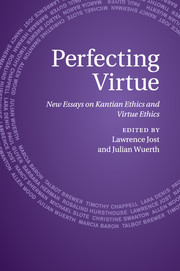Book contents
- Frontmatter
- Contents
- Notes on contributors
- Acknowledgements
- List of abbreviations
- Introduction
- 1 Virtue ethics in relation to Kantian ethics: an opinionated overview and commentary
- 2 What does the Aristotelian phronimos know?
- 3 Kant and agent-oriented ethics
- 4 The difference that ends make
- 5 Two pictures of practical thinking
- 6 Moving beyond Kant's account of agency in the Grounding
- 7 A Kantian conception of human flourishing
- 8 Kantian perfectionism
- 9 Aristotle, the Stoics, and Kant on anger
- 10 Kant's impartial virtues of love
- 11 The problem we all have with deontology
- 12 Intuition, system, and the “paradox” of deontology
- Bibliography
- Index
9 - Aristotle, the Stoics, and Kant on anger
Published online by Cambridge University Press: 04 February 2011
- Frontmatter
- Contents
- Notes on contributors
- Acknowledgements
- List of abbreviations
- Introduction
- 1 Virtue ethics in relation to Kantian ethics: an opinionated overview and commentary
- 2 What does the Aristotelian phronimos know?
- 3 Kant and agent-oriented ethics
- 4 The difference that ends make
- 5 Two pictures of practical thinking
- 6 Moving beyond Kant's account of agency in the Grounding
- 7 A Kantian conception of human flourishing
- 8 Kantian perfectionism
- 9 Aristotle, the Stoics, and Kant on anger
- 10 Kant's impartial virtues of love
- 11 The problem we all have with deontology
- 12 Intuition, system, and the “paradox” of deontology
- Bibliography
- Index
Summary
VIGNETTES
Consider three cases to help focus intuitions.
First, vengeful anger Iranian style. I quote from an article in the Scottish Daily Mail of March 17, 2005:
Justice took a long time to catch up with the man they called the vampire of the desert. Death came just as slowly. Under the blazing hot sun, in front of a baying crowd, Mohammad Bijeh paid a very public price yesterday for his catalogue of wicked crimes.
In a grossly barbaric execution ceremony, the serial child killer was flogged at the stake, stabbed in the back by the 17-year-old brother of one of his victims and stoned by the chanting mob.
Then, to shouts of “make him twist,” he was hoisted up on a crane by a noose that had been placed around his neck by the mother of another victim.
It took more than five minutes for him to choke to death, while he was taunted and spat at …
His corpse was then left dangling for another 20 minutes.
We can think of the scene as one of vengeful anger where the legal punishment system facilitates private revenge through public, barbaric punishment.
Next, consider classic vengeful anger within war: I refer to the warrior rage of Homer's Achilles. Achilles is the angriest, “most violent man alive,” proclaims Agamemnon, himself famous for the vindictiveness that sets the Iliad in motion and that provokes Achilles' rage.
- Type
- Chapter
- Information
- Perfecting VirtueNew Essays on Kantian Ethics and Virtue Ethics, pp. 215 - 240Publisher: Cambridge University PressPrint publication year: 2011
- 1
- Cited by

